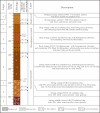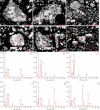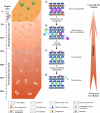Characteristics and paleoclimate significance of authigenic ferrimagnetic minerals in the Xuancheng red earth, southern China
- PMID: 39870708
- PMCID: PMC11772578
- DOI: 10.1038/s41598-025-87020-9
Characteristics and paleoclimate significance of authigenic ferrimagnetic minerals in the Xuancheng red earth, southern China
Abstract
Soil magnetic records in Quaternary red earth (QRE) deposits contain a valuable record of paleoclimate information, providing insights into controls on Earth's climate system in the past and potentially helping to predict its response to perturbations in the future. Here, analysis of the environmental magnetism and mineralogy of the Xuancheng QRE (Anhui Province, South China) shows that magnetic variation was strongly linked to production of authigenic ferrimagnetic minerals such as maghemite. Fine-grained maghemite formed during the weathering-related transformation of iron-bearing illite to vermiculite, generating aggregates of vermiculite or mixed-layer illite-vermiculite. Enclosure of authigenic ferrimagnetic minerals by illite and vermiculite-group minerals inhibits their chemical weathering, but this protective effect can be lost due to intensified weathering, allowing the authigenic ferrimagnetic minerals to transform into more stable antiferromagnetic minerals. Upsection within the Xuancheng QRE, the content of authigenic ferrimagnetic minerals gradually increases, as revealed by SIRM and SIRM/χ, indicating a decrease in weathering intensity as the regional climate evolved from warm and wet in the middle Pleistocene to relatively cooler and drier today. Thus, this study improves our understanding of the relationship between soil magnetic properties and paleoclimate evolution in QRE deposits.
Keywords: Clay minerals; Fe oxides; Maghemite; Magnetite; Quaternary; Vermiculite.
© 2025. The Author(s).
Conflict of interest statement
Declarations. Competing interests: The authors declare no competing interests.
Figures






References
-
- Hu, X. F., Wei, J., Xu, L. F., Zhang, G. L. & Zhang, W. G. Magnetic susceptibility of the quaternary red clay in subtropical China and its paleoenvironmental implications. Palaeogeogr. Palaeoclimatol. Palaeoecol.279, 216–232 (2009).
-
- Hong, H. L., Gu, Y. S., Li, R. B., Zhang, K. X. & Li, Z. H. Clay mineralogy and geochemistry and their palaeoclimatic interpretation of the Pleistocene deposits in the Xuancheng section, southern China. J. Quat. Sci.25, 662–674 (2010).
-
- Yin, K. et al. Hydroxy-interlayered vermiculite genesis in Jiujiang late-pleistocene red earth sediments and significance to climate. Appl. Clay Sci.74, 20–27 (2013).
-
- Xiong, S. F., Sun, D. H. & Ding, Z. L. Aeolian origin of the red earth in southeast China. J. Quat. Sci.2, 181–191 (2002).
-
- Yin, Q. Z. & Guo, Z. T. Mid-pleistocene vermiculated red soils in southern China as an indication of unusually strengthened east Asian monsoon. Chin. Sci. Bull.51, 213–220 (2006).
Grants and funding
- 41402036/National Natural Science Foundation of China
- 41402036/National Natural Science Foundation of China
- 41402036/National Natural Science Foundation of China
- 41402036/National Natural Science Foundation of China
- 41402036/National Natural Science Foundation of China
- 41402036/National Natural Science Foundation of China
- 41402036/National Natural Science Foundation of China
- 41402036/National Natural Science Foundation of China
- 41402036/National Natural Science Foundation of China
- 41402036/National Natural Science Foundation of China
- 41402036/National Natural Science Foundation of China
- 41402036/National Natural Science Foundation of China
- CUG170106/Fundamental Research Funds for the Central Universities
- CUG170106/Fundamental Research Funds for the Central Universities
- CUG170106/Fundamental Research Funds for the Central Universities
- CUG170106/Fundamental Research Funds for the Central Universities
- CUG170106/Fundamental Research Funds for the Central Universities
- CUG170106/Fundamental Research Funds for the Central Universities
- CUG170106/Fundamental Research Funds for the Central Universities
- CUG170106/Fundamental Research Funds for the Central Universities
- CUG170106/Fundamental Research Funds for the Central Universities
- CUG170106/Fundamental Research Funds for the Central Universities
- CUG170106/Fundamental Research Funds for the Central Universities
- CUG170106/Fundamental Research Funds for the Central Universities
- 2014M562084/China Postdoctoral Science Foundation
- 2014M562084/China Postdoctoral Science Foundation
- 2014M562084/China Postdoctoral Science Foundation
- 2014M562084/China Postdoctoral Science Foundation
- 2014M562084/China Postdoctoral Science Foundation
- 2014M562084/China Postdoctoral Science Foundation
- 2014M562084/China Postdoctoral Science Foundation
- 2014M562084/China Postdoctoral Science Foundation
- 2014M562084/China Postdoctoral Science Foundation
- 2014M562084/China Postdoctoral Science Foundation
- 2014M562084/China Postdoctoral Science Foundation
- 2014M562084/China Postdoctoral Science Foundation
LinkOut - more resources
Full Text Sources
Miscellaneous

